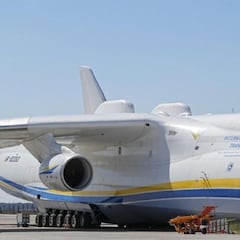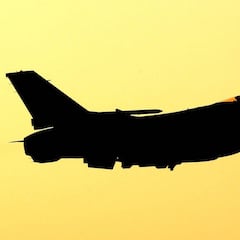What countries are the nuclear powers of the world? How many nuclear weapons are there?
By the mid-1980s, there were over 64,000 nuclear warheads. That number has reduced dramatically but more countries now have the doomsday weapon.

The most destructive weapon ever developed, nuclear weapons have only been used twice in war, both times on Japanese cities, Hiroshima and Nagasaki, by the US at the end of World War II. Over the course of the Cold War, the arms race between the US and the Soviet Union saw the global stockpile swell to over 64,000 warheads.
However, the two superpowers reached agreements to radically reduce their stockpiles bringing the total worldwide nuclear arsenal down to under 10,000 currently. The vast majority of nations around the world have signed onto the Non-Proliferation Treaty (NPT) to prevent the spread of nuclear weapons with a commitment from those that have nuclear weapons to reduce their arsenals.
Also see:
- Theories about the mysterious 'Z' on Russian tanks in Ukraine
- Can Ukraine join EU and how long would it take?
- Russia destroys world's largest plane, the AN-225 Mriya
- How Russia-Ukraine war fits into Biden's State of the Union
- The Crimean Peninsula and the Russia-Ukraine conflict
There are five defined nuclear-weapon states, the United States, Russia, the United Kingdom, France and China, which possessed the working atom bombs prior to 1967. But four others have developed the technology, or are believed to have done so since the treaty went into effect in 1970. Israel, India, Pakistan and North Korea, which also happen to be four nations that do not accept the NPT.
Several nations have tried to develop their own programs before and after the NPT. Most recently Iran in in non-compliance with the treaty that is supposed to prevent more nation becoming capable of creating a nuclear bomb.
Dirty bombs also called radiological dispersal device
There is also the worry of rogue nations building or terrorist organization getting their hands on radioactive material to build a “dirty bomb” also known as radiological dispersal device (RDD) to use. This was almost the case when Daesh, better know as ISIS, nearly got their hands on cache of cobalt-60, which is used to kill cancer cells, when they overran Mosul.
A dirty bomb is not like a nuclear weapon of mass destruction but instead a "weapon of mass disruption," used to cause panic and contamination. It created using conventional explosives to disperse the radioactive material.
Russian propaganda has gone off the rails and speculates Ukraine might be preparing to drop a ‘dirty bomb’ on the Russian territory. This is a sick fake. Ukraine doesn’t have nuclear weapons, doesn’t conduct any work to create/acquire them. We are a responsible member of the NPT.
— Dmytro Kuleba (@DmytroKuleba) February 26, 2022
Current national nuclear weapon stockpiles
The current worldwide stockpile sits just under 10,000 warheads but not all of them can be deployed at a moments notice. Still, those that are available would wreak unimaginable destruction to human life and alter the Earth’s climate. Not all nations are transparent about the exact number of warheads in their nuclear arsenals, or whether they even possess them.
Israeli nuclear arsenal
That is especially the case with Israel which has a secret program and practices a policy of ambiguity in relation to having the bomb. It's believed they may have built their first bomb in 1967. By 2000 it is estimated that the nation had between 60 and 80 warheads and could increase their stockpile to 65 or 85 by 2020 according to research for the Nuclear Notebook by Hans M. Kristensen and Matt Korda at the Bulletin of Atomic Scientists.
Of Russia's 4,477 nuclear warhead stockpile, 1,588 strategic warheads are deployed on ballistic missiles and at heavy bomber bases.
— Federation of American Scientists (@FAScientists) February 24, 2022
Read our full assessment of Russia's nuclear arsenal in @BulletinAtomic https://t.co/t9p8ZRNlhY
North Korean nuclear arsenal
North Korea is the newest member of known nuclear powers detonating their first bomb in 2006. The nation, although a signatory of the NPT never acceded to the treaty and formally withdrew in 2003. Very little is known about the stockpile in the Hermit Kingdom but the according to the Nuclear Notebook it’s estimated that North Korea could have enough fissile material to build 40 to 50 nuclear weapons. However, at best guess the nation has only built 10 to 20 warheads that could be delivered on medium-range ballistic missiles.
Indian and Pakistani nuclear arsenals
The two subcontinent nations and regional rivals both revealed their nuclear capabilities just weeks apart in May 1998. India for its part had previously detonated a nuclear device in 1974 in a “peaceful” demonstration. The Nuclear Notebook estimates that Pakistan has around 165 warheads, while India has around 150 but will most likely be building more to fit onto a new missile system it is developing. It is also constructing new breeder reactors to produce more fissile material that will come online sometime after 2030
Nuclear arsenals of the UK and France
The UK and France became nuclear powers in 1952 and 1960 respectively. The UK began reducing its stockpile of warheads starting in 1980 coming down from a high of 500 to around 225 currently. However, not all of the warheads are in service. Additionally, the government recently increased the upper limit to 260 warheads for the nation’s nuclear inventory.
France started decreasing the number of nuclear weapons in its arsenal in 2000. It is one of the most transparent nuclear-armed states. The number of warheads in the French inventory has remained the same for the past decade around 300.
#SubSunday: USS Sam Rayburn (SSBN 635) circa the late 1960s. One of 10 James Madison-class ballistic missile submarines designed to deter nuclear attacks through #StrategicDeterrence patrols with Polaris missiles. Converted to a moored training ship after deactivation in 1985. pic.twitter.com/MeIlOMWfyp
— U.S. Naval Undersea Museum (@underseaNavy) February 27, 2022
China’s nuclear arsenal
China was the last nation to join the nuclear-weapon states acquiring the atom bomb in 1964. The Nuclear Notebook estimates China has 350 nuclear warheads in its triad of land, sea and air delivery systems. The US government expects that China will increase its nuclear warhead inventory to a minimum of 1,000 by 2030.
The US nuclear arsenal
At its peak the in the 1960s, the US had over 31,000 warheads. Even prior to President Ronald Regan and Premier Mikhail Gorbachev reaching an initial agreement to draw down nuclear inventories the US began cutting the number of warheads it had. In 1991, President George HW Bush and Gorbachev signed the Strategic Arms Reduction Treaty (START I), which limited the number of nuclear warheads that could be deployed and created a parity between the two nations inventories.
Related stories
According to Nuclear Notebook it is estimated that the United States had around 1,750 warheads deployed in 2019 from its stockpile of 3,800. The remaining warheads “are in storage as a so-called hedge against technical or geopolitical surprises.”
The nuclear arsenal of Russia
The Russian stockpile peaked in 1986, when it was still part of the Soviet Union, at over 40,000 at its disposal. To meet its obligations under the START I and later treaties it has reduced its inventory dramatically. The Russian Federation currently possesses roughly 4,477 warheads. It is in the process of modernizing its inventory to replace Soviet-era kit, a process that is almost 90 percent complete.


